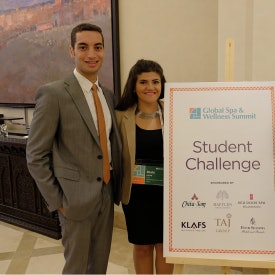
GSWS Day 2 began with Part II of the now-traditional Student Challenge, with two university teams presenting to the judges and attendees. Moderated by Susan Harmsworth and Prof. Mary Tabacchi, this morning’s presentation featured students from The American University in Cairo, Egypt, and ESSEC Business School in Cergy Pontoise, France. The other two schools participating, Al Akhawayn University in Ifrane, Morocco, and Mohammed V University from Rabat, Morocco, had already presented to the judges’ panel: Diana Banks from Raffles, Simon Casson of Four Seasons, Andrew Gibson of Fairmont, Sheila McCann from Chiva-Som, Bina Patel of The Indian Hotels Co. Ltd (Taj), Frank Strobel of KLAFS, and Todd Walter of Red Door. The students, working in small groups with an academic advisor, are tasked with creating a design and concept for a spa of the future that, in this case, features North African culture. The spa model needs to be something that could be scaled globally and commercially viable.
New at this year’s GSWS were a number of concurrent General Session presentations, making for some difficult choices among the delegation. Those not watching the student competition could gain some knowledge of local history by attending The Real Story of Moroccan Argan Oil, delivered by Prof. Zoubida Charrouf from University of Mohammed V, and Traditional Medicines of Africa, presented by Prof. Gerry Bodeker of Oxford and Columbia.
The next General Session presentation time slot also offered a choice; I attended Enlightened Illumination in the Spa of the Future, delivered by prominent local artist Yahya Rouach. Rouach stumbled into his current work—creating light fixtures and decorative home accessories made from metal and featuring traditional Moroccan design—after noticing how his son, at the time a crying baby, was calmed by looking at the patterns created by light. Rouach has observed how important lighting is in creating mood and environment.
The alternative session, Promoting Hydrothermal Businesses, was moderated by Erica Orange of Weiner, Edrich and Brown, and featured remarks and participation by experts who design, own and/or operate spas with hydrothermal facilities, including Don Genders, Roberto Cemin, Adrian Egger and Wilfried Dreckmann, among others. Notes from that conversation will be available on the GSWS website.
Ophelia Yeung and Katharine Johnston of SRI International presented the result of their project this year: welcome updates on the seminal SRI 2008 report, the Global Spa Economy. Many things have changed in the world and in the spa and wellness industry since 2008, and it was definitely time to revisit the data. The detailed report will be forthcoming, but here are some of the high-level findings:
- the spa and wellness cluster is now estimated at $US3.4 trillion for 2013 (all estimates in $US)
- wellness & lifestyle products and services valued at $2.8billion
- wellness tourism $494bn
- spa industry cluster $94bn, and the world added 34k spas
- day spa growth is leading the way in many markets
- spa market growth in world regions 186% in Africa, 65% A-Pac, 86% Latin America/Caribbean, 134% MENA, 62% Europe, 35% North America
- mineral and hot springs spa industry valued at $50bn, with 26,847 establishments in 103 countries
SRI also conducted an online poll of 1000 spa professionals. The findings:
- Challenges: trained workforce, competitive environment, discounting demand, costs
- Future Drivers: authenticity, results, local, anti-aging, coaching, mental wellness, prevention, workplace wellness, CAM
- Opportunities: evidence, technology, recruitment, education, standards
Yeung and Johnston urged the industry to continue with the development of standards, as they give consumers confidence. They recommended that industry clusters work together collaboratively to improve our competitiveness, and commended our industry, as evidenced by the GSWS, for being one of the first to attempt to organize at a global, rather than local, level.
Also new this year, during twice daily coffee breaks, attendees were given the option of attending small breakouts called “Up Close and Personal” with various speakers, held in a garden, or participating in a mindful meditation practice led by Felix Lopez of the Jhana Healing Mindfulness and Yoga Center in the U.S. Many delegates were eager to take part in the meditation, much needed in the midst of so much activity and mental stimulation. —Lisa Starr



![[VIDEO] An Osmosis Facial Infusion Treatment Step-by-Step](https://native-x.imgix.net/allured/663137812f619a000179e394/Thumbnail-Sized.jpg?crop=focalpoint&fit=crop&fp-x=0.5&fp-y=0.5&h=191&w=340&auto=format%2Ccompress&q=70)







